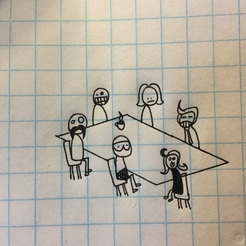|
Awkward trips to the doctor with your dad including questions asked of a young woman in an open room. First the regular questions with the regular answers and then it gets real personal, really fast...Is this really necessary? In our family awkward conversations are a cornerstone of our philosophy - if we aren't having those awkward conversations about taboo topics with our children then someone else is. As a parent you have to decide whether you are going to create an environment where your children can ask you any question, regardless of content, so that you can discuss as a family or if you are willing to allow outside influences to be the sounding board for those in your care.
Uncomfortable conversations start at a young age often with bad words, how you respond and deal with your children discovering alternative language will set a precedent for how young ones will or will not bring questions to you about things they see, hear and experience throughout their life. A great starting point that we were encouraged to use for example would be that when a child hears a word that they do not understand (even if that is a four letter word) they should wait until they get home and bring it up at the dinner table so that the family can discuss the meaning of the work and whether this is a word that our family should be using. We can take away the power of negative words by understanding them and explaining the use of language and reclaiming its beauty. We can create an environment of communication in our homes by turning taboo into teaching moments. We believe that it is so important to remember as a parent that if you are not having these awkward conversations with your children, someone else is.
0 Comments
Millennials get tagged as entitled, if you want to find the source of those attributes try parking or standing in line at Costco. That pattern of adults behaving badly has been handed down from generations. If you are raising millennials or generation next and you are concerned that they might turn out like those kids, take an inventory of your own practices and attitudes as so much of what children become is caught more than it is taught. Set a good example and do your best to raise them right, the habits of upcoming generations may be more of a mirror than we would like to admit.
In business there are rituals that neither management nor employees enjoy and yet they are widely practiced because a) it’s what everyone else is doing, b) we’re required to do it by the unwritten codes of business handed down from our ancestors and/or c) leadership is unwilling to admit that something needs to change. Enjoy our fun video that reviews the tried-and-failing process of annual employee reviews as acted out by children. If you do not recognize a need to evaluate and improve your processes, you are probably right – everything is fine and you are going to be awesome (sarcasm). But, if you recognize that there are always areas that can improve, you may start by relieving the additional strain on managers as well as the deflating of employee morale that is often tied to the annual employee review as currently practiced.
There are plenty of examples of what isn’t working, please tell us what you have been trying and what is working with improving employee engagement. Please help up gather some data on process improvement by taking our brief survey HERE. Keep doing good things.  How does one network is the wrong question. In fact, its a dumb question that will lead to many hours spent chasing rooms full of hollow people gathered for free coffee and stale donuts (Exhibit A). How does one find and/or start a gathering of professionals that will generate mutually beneficial relationships? This is the right question or at least a question that will lead to better results that that other stupid question that you started with. What do you do if you have an Exhibit A mentality but you want to stop asking dumb questions and attending dumb meetings? Step 1: Define what you are doing (or what it is that you want to do). Answer the key question - what is your business? Step 2: Find others who are doing what you are doing? Step 3: Observe others who are doing what you are doing and take note both of A) what is working and B) what is not working from the subjects you are observing that are doing what you are doing. Step 4: Attempt to gather with those professionals who are doing what you are doing and that fall into category (A) from Step 3. This is value focused networking. Networking by its Google definition (ˈnetˌwərk) involves interaction + exchange of information + development of contacts especially to further one’s career. It is a verb. In order for a group to create a collection of valuable persons they must collectively define what value will look like, pursue persons in that vein and then deputize the membership to grow those connections. A cattle call will bring the cattle in, but that won’t do if your group is looking for birds of prey. Might we recommend our trademark the master equation of quality networking, A + B = C (When and only when): A = quality of members B = quantity of member involvement C = a strong localized networking group Conversely, C is not achieved when: A = a bunch of random visionless people assembled in a room B = irregardless of their activity, in fact their activity may be hurting them. Stop them immediately and refer them to this article.  Remember, we are not seeking Exhibit A individuals or groups (as referenced in our opening statements). Our rally cry is not a cattle call for the masses of grazing business persons who are willing to sit in a stagnant field of mediocrity nibbling on trampled greens. We are becoming Exhibit B individuals who are building Exhibit B groups that are following the master equation. We are a gathering of professionals who are birds of prey in their personal and professional lives, hunting and devouring business flesh with their wings outstretched in glorious displays of plumage. A strong value-centric group should be able to answer: Why are we here meeting with strangers? Define what the group is about. What will we do to elevate each other? Establish what quality looks like and apply that as a standard to attracting members and structuring the group. How will we push each other? Generate momentum by living lives of vision that are enhanced by the sharing of insights, experiences and encouragement exchanged between members of the group. Members working together to define objectives, elevate each other and work towards collective goals is a decent manifestation of humanity as well as the secret sauce (aka master equation) that can fuel a local group of professionals into mutually beneficial relationships. |
AuthorThoughts on personal and professional development. Jon Isaacson, The Intentional Restorer, is a contractor, author, and host of The DYOJO Podcast. The goal of The DYOJO is to help growth-minded restoration professionals shorten their DANG learning curve for personal and professional development. You can watch The DYOJO Podcast on YouTube on Thursdays or listen on your favorite podcast platform.
Archives
March 2023
Categories
All
<script type="text/javascript" src="//downloads.mailchimp.com/js/signup-forms/popup/unique-methods/embed.js" data-dojo-config="usePlainJson: true, isDebug: false"></script><script type="text/javascript">window.dojoRequire(["mojo/signup-forms/Loader"], function(L) { L.start({"baseUrl":"mc.us5.list-manage.com","uuid":"b9016446bd3c6a9f0bd835d4e","lid":"83282ffb9e","uniqueMethods":true}) })</script>
|
Jon Isaacson |
Connect. Collaborate. Conquer.
© COPYRIGHT 2015. ALL RIGHTS RESERVED.
|



 RSS Feed
RSS Feed